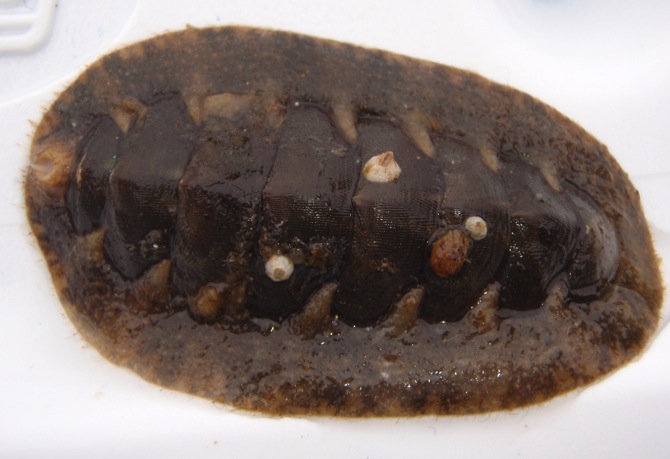Hind's mopalia, encrusted hairy chiton • Mopalia hindsii
Identification
The girdle of this chiton is sparsely hairy and has a conspicuous notch at the posterior end. It grows to 10 cm long, and has variable girdle and plate markings. The plates may be marked with blue lines.
Habitat & Range
This species is commonly found under rocks in the intertidal. It is also found subtidally and on pilings, and occurs on exposed as well as sheltered shorelines. Its range extends from central Alaska to northern Mexico.
Similar Species
The mossy chiton (Mopalia muscosa) and the wood chiton (Mopalia lignosa) also have girdle hairs - these hairs are more dense, and neither has a posterior notch in the girdle. The hairy chiton (Mopalia ciliata) does have this notch, but its girdle hairs are strap-like and occur more densely.
iNaturalist
https://www.inaturalist.org/taxa/51725-Mopalia-hindsii
The girdle of this chiton is sparsely hairy and has a conspicuous notch at the posterior end. It grows to 10 cm long, and has variable girdle and plate markings. The plates may be marked with blue lines.
Habitat & Range
This species is commonly found under rocks in the intertidal. It is also found subtidally and on pilings, and occurs on exposed as well as sheltered shorelines. Its range extends from central Alaska to northern Mexico.
Similar Species
The mossy chiton (Mopalia muscosa) and the wood chiton (Mopalia lignosa) also have girdle hairs - these hairs are more dense, and neither has a posterior notch in the girdle. The hairy chiton (Mopalia ciliata) does have this notch, but its girdle hairs are strap-like and occur more densely.
iNaturalist
https://www.inaturalist.org/taxa/51725-Mopalia-hindsii
References
Cowles, D. (2008). Mopalia hindsii (Sowerby in Reeve, 1847). Invertebrates of the Salish Sea. Rosario Beach Marine Laboratory. Accessed 03/11/2014.
Harbo, R. M. (1999). Whelks to whales: Coastal marine life of the Pacific Northwest. Madeira Park, BC: Harbour Publishing. P. 124.
Lamb, A., and Hanby, B. (2005). Marine Life of the Pacific Northwest [electronic version]. Madeira Park, BC: Harbour Publishing.
Authors and editors of page
Kelly Fretwell and Brian Starzomski (2014).
Cowles, D. (2008). Mopalia hindsii (Sowerby in Reeve, 1847). Invertebrates of the Salish Sea. Rosario Beach Marine Laboratory. Accessed 03/11/2014.
Harbo, R. M. (1999). Whelks to whales: Coastal marine life of the Pacific Northwest. Madeira Park, BC: Harbour Publishing. P. 124.
Lamb, A., and Hanby, B. (2005). Marine Life of the Pacific Northwest [electronic version]. Madeira Park, BC: Harbour Publishing.
Authors and editors of page
Kelly Fretwell and Brian Starzomski (2014).





